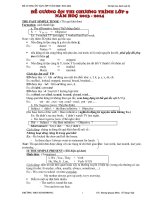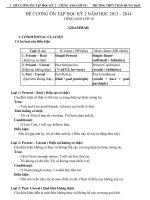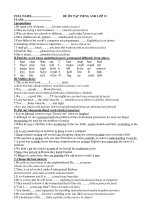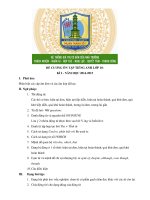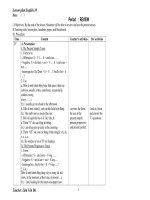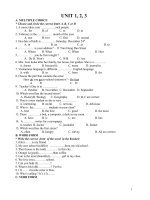ĐỀ TÀI: Lesson plan English 10 tóm tắt và ôn tập tiếng Anh lớp 10
Bạn đang xem bản rút gọn của tài liệu. Xem và tải ngay bản đầy đủ của tài liệu tại đây (630.69 KB, 165 trang )
Lesson plan English 10
Date: / /
Period : REVIEW
I. Objectives: By the end of the lesson, Students will be able to review and use the present tenses.
II.Teaching aids: lesson plan, handouts, paper, and blackboard.
III. Procedure:
Time Content Teachers activities Sts activities
25 A. Presentation
I. The Present Simple Tense
1. Form to be
- Affirmative: S + V1. S + am/is/are
- Negative: S + do/does + not + V S + am/is/are +
not
- Interrogative: Do/Does + S + V.? Am/Is/Are + S
.?
2. Use
a. Diễn tả một hành động hoặc thói quen ở hiện tại
(always, usually, often, sometimes, occasionally,
seldom, rarely,
every.)
Ex: I usually go to school in the afternoon.
b. Diễn tả một chân lý, một sự thật luôn luôn đúng.
Ex: The earth moves around the sun.
3. Đối với ngôi thứ ba số ít: He, She, It.
a. Thêm S vào sau động từ thờng.
Ex: Lan often gets up early in the morning.
b. Thêm ES vào sau các động từ tận cùnglà : ch, sh,
s, x, o, z.
Ex: He watches a lot of TV on Sundays.
II. The Present Progressive Tense
1. Form
- Affirmative: S + am/is/are + V-ing
- Negative: S + am/is/are + not + V-ing
- Interrogative: Am/Is/Are + S + V-ing .?
2. Use
Diễn tả một hành động đang xảy ra trong lúc nói
(now, at the moment, at this time, at present.)
Ex: - I am looking for the latest newspaper now.
-reviews the form,
the use of the
present simple,
present progressive
and present perfect.
-look at, listen
and answer the
Ts questions.
Teacher: Lõm Vn
1
Lesson plan English 10
- They are watching a sport game show at the
moment.
3. Note:
Một số động từ không dùng ở thì Present Progressive,
mà chỉ dùng ở thì Present Simple: to be, to want, to
need, to have (có), to know, to understand.
Ex: - We are tenth-grade students now.
- I understand the lesson at the moment.
III. The Present Perfect Tense
1. Form
- Affirmative: S + has/have +V3/ed.
- Negative: S + has/have + not + V3/ed
- Interrogative: Has/Have + S + V3/ed.?
2. Use
a. Diễn tả một hành động xảy ra trong quá khứ và kéo
dài đến hiện tại (never, ever, notyet, since, for, so
far, until now, up to now,.)
Ex: We have learnt English for 5 years.
b. Diễn tả một hành động vừa mới xảy ra (just,
recently, lately).
Ex: She has just gone out.
c. Diễn tả một hành động xảy ra trong quá khứ không
xác định rõ thời gian (already, before)
Ex: Have you seen this movie before?
3. Notes
a. Cách dùng của since và for
- SINCE: chỉ mốc thời gian (2000, September, I last
saw you, )
- FOR: chỉ khoảng thời gian (3 months, a long time,
ages, )
b. S + has/have +V3/ed since + S + V2/ed.
Ex: We have known each other since we worked in
this factory.
c. Các trạng từ: never, ever, just, already thờng đứng
giữa trợ động từ (has/ have) và động từ chính (V3/ed).
Ex: I have already finished my homework.
EXERCISES
Teacher: Lõm Vn
2
Lesson plan English 10
18’
1’
1’
Put the verbs in parentheses into the correct tense:
1. He (practice)_______________ the piano every
day.
2. I (believe)____________ you.
3. Bob (see)______________ this movie before.
4. Jorge (read)____________ the newspaper already.
5. Maria (have)_____________ a cold now.
6. He (swim)_____________ right now.
7. Mr. Johnson (work)____________ in the same
place for 35 years.
8. We (not begin)_____________ to study for the test
yet.
9. John (hate)____________ smoke.
10. Jill always (get up)____________ at 6.00 a.m.
11. Joan (travel)___________ around the world.
12. We (not see)_____________ this movie yet.
13. Terry (mow)__________ the lawn yet.
14. John and I (be)______________ pen pals for
nearly 3 years.
15. Maryam (stay)____________ with us at the
moment.
16. He (wear)___________ the same coat since he
(move)___________ here.
17. I (not see)_____________ your brother recently.
18. Listen to those people! What language they
(speak) _________?
19. It (not rain)______________ much in our country
in winter.
20. I never (talk)_____________ to such an
interesting person.
IV. Consolidation
Brief summary
V. Homework
Review the tenses
-gets Ss to do the
exercises.
- Helps sts make
brief summary of
the lesson
- Gives task
1. practices
2. believe
3. has seen
4. has read
5. has.
6. is swimming
7. has worked
8. have not
begun
9. hates
10. gets up
11. has traveled
12. have not seen
13. has mowed
14. have been
15. is staying
16. has worn/
moved
17. have not seen
18. are they
speaking
19. does not rain
20. have never
talked
- Try to make
summary
- Listen
Teacher: Lâm Văn Đủ
3
Lesson plan English 10
Period : REVIEW
Date : / /
I. Objectives : helps sts practice doing exercises about present perfect and present perfect passive
II. Teaching aid : Lesson plan
III. Method : communicative
IV. Procedure
Time Content Teacher’s activities Sts’ activities
25’
20’
Exercise 1 : Complete the second sentence, using the
present perfect.
1. My hair is tidy now. I’ve brushed my hair.
2. The door is open. Someone ____ the door.( open )
3. This is Oliver’s drawing, look. Oliver ______ a
picture. ( draw )
4. The calculator is broken. Someone _______ the
calculator. ( break )
5. United are the winners. United _________ the
game. ( win )
6. There’s no more wine in the bottle. We ______ all
the wine. ( drink )
7. The floor is clean now. I ___ the floor. ( clean )
8. I know my number now. I _______ my number
by heart. ( lean )
* Answer :
2. has opened 5. has worn 8. have learned
3. has drawn 6. have drunk
4. has broken 7. have cleaned
Exercise 2 : Active or Passive? Underline the correct
verb form.
1. Tom has just promoted / has just been promoted
to area manager of East Asia.
2 . My father has taken / has been taken English
class in the U.S.
3. How many times have you / have you been fired?
- Writes exercise on
board and asks sts to
work individually
- Goes round and
helps
- Gets sts’ answers
- Checks and gives
feedback
- Writes exercise on
the board
- Has sts do
individually
- Has sts compare
with friends
- Gets sts’ answers
- Write on the
notebook and
work individually
- Ask for help if
needed
- Give answers
- Whole class and
copy down
- Write on the
notebook
- Do individually
- Compare with
friends
- Give answers
Teacher: Lâm Văn Đủ
4
Lesson plan English 10
4. How much money have you saved / have you been
saved for your vacation.
5. My brother has given / has been given tickets to
the concert .
6. The population of our city has risen / has been
risen to nearly one million.
7. A strike has called / has been called by the factory
worker.
8. They haven’t offered / haven’t been offered more
money by the management.
* Answer :
1. has just been promoted 5. has been given
2. has taken 6. has risen
3. have you 7. has been called
4. have you saved 8. haven’t been offered
- Checks and gives
feedback
- Copy down
UNIT 1: A DAY IN THE LIFE OF…
Lesson 1: Reading Period: Date:
I/ AIMS: Reading for specific information about a day in the life of a farmer.
II/ OJECTIVES: By the end of the lesson, students will be able to talk about their daily routines by learning a typical day of a farmer.
III/ LEXICAL ITEMS: Vocabulary
IV/ TEACHING AIDS: Textbook, pictures about farmer and field work…
Teacher: Lâm Văn Đủ
5
Lesson plan English 10
Teacher: Lâm Văn Đủ
T CONTENTS TEACHER’S STUDENTS’
7’
10’
5’
5’
5’
A . WARM UP: Chatting
T: What time do you often get up?
S: I often get up at six.
_ What time you go to school/ have breakfast/ lunch/
dinner/ go to bed.
_ What you often do in the morning/ afternoon/ evening.
B. NEW LESSON :
1. Pre- reading :
VOCABULARY:
_ plough (v): furrow, turn up the soil.
_ harrow (v): break the soil.
_ plot of land (translation).
_ fellow peasants (n): farmers working in the same field
_ local tobacco (translation)
_ take a short rest (v): have a rest for a short time.
_ transplant (v): grow rice.
_ crop (n): (translation)
2.While reading:
TASK1:Multiple choice.
1 2 3 4
C C A A
TASK2: Answering questions
1. He’s a peasant/ farmer.
2. He gets up at 4:30 and then he goes down to the
kitchen to boil some water for his morning tea.
3. In the morning he ploughs and harrows his plot of land,
drink tea and smokes local tobacco during his break.
4. In the afternoon, they repair the banks of their plot of
land. Mr. Vy pumps water into it while his wife does the
transplanting.
5. Yes, they are. Because they love working and they
love their children.
TASK3:Note completion.
In the
morning
4:30:alarm goes off, Mr.Vy gets up, goes down
to the kitchen, boils water for tea, drinks tea,
has a quick breakfast, leads the buffalo to the
field.
5:15: leaves the house
Tells Ss to ask and
answer about their
daily routines by
using the cues.
Teaches vocabulary
Model
Writes the words on
the board.
Asks Ss to read the
passages individually
and choose the option
A, B or C that best
suits the meaning of
the italicized word(s).
Goes around & gives
help. Calls on some
Ss to read aloud their
answers
Asks them to explain
their choice.
Have ss work in pairs
, ask and answer
about the passages.
Calls on some pairs
to do the task in front
of the class.
Gives feedback and
suggested answers.
Asks Ss scan the
passage & make a
brief note about
Mr.vy & Mrs.Tuyet’s
daily routines.
Pair work
Individual work.
Whole class.
Listen.
Repeat.
Write out.
Work individually
Work in pairs
6
Lesson plan English 10
UNIT 1: A DAY IN THE LIFE OF…
Teacher: Lâm Văn Đủ
7
Lesson plan English 10
Lesson 2: Speaking Period: Date:
I/ AIMS: Speaking about one’s daily routine.
II/ OJECTIVES: By the end of the lesson , students will be able to talk about his or her daily routine by using given information and pictures.
III/ LEXICAL ITEMS: Vocabulary
IV/ TEACHING AIDS: Textbook, small cards of class timetable,…
V/ PROCEDURE:
T CONTENTS TEACHER’S STUDENTS’
10’
10’
15’
A . WARM UP: Revision of school subjects
SUBJECTS
B. NEW LESSON :
1. Pre- speaking : VOCABULARY
_ tenth-grade student:
_ weekly timetable:
_ Civic Education:
_ class meeting:
* What time does Quan have + subject + on + day? ask
about the time of subject.
* What lesson does Quan have at + time + on + day? ask
about the lesson.
TASK 1:Quan is a tenth-grade student. He goes to school
every morning. Now, look at his weekly timetable on page 15.
Ask and answer questions with a partner, using the
information from the timetable.
A: What time does Quan have Civic Education lesson on
Monday?
B: He has Civic Education lesson at 7:15 a.m.
A: What lesson does Quan have at 7:15 a.m. on Monday?
B: Civic Education
2. While speaking:
Divide the class
into small groups.
Ask SS to make a
list of the subjects
they learn at
school.
Elicits, teaches
words
Lets Ss work in
pairs about Quan’
routine.
Group work
Pair work
Pair work
Teacher: Lâm Văn Đủ
8
SUBJECTS
Lesson plan English 10
7’
3’
TASK 2: Talk about Quan’ activities, using the pictures.
Suggested answer:
Everyday Quan gets up at 14:00. Then he studies for about
two hours. He watches TV at 16:30. At 17:00 he rides to the
stadium to play football with other boys in the neighborhood.
He gets back home at 18:30. After having a shower, he has
dinner with his family at 19:00. He prepares for the following
day’s lesson at 20:00.
3. After speaking:
TASK 3:Tell yur classmates about your daily routine.
Suggestion:
_ In the morning:
6:00: I get up and have breakfast.
7:00; I go to school an have five lessons.
12:00: I get back home and have lunch.
_ In the afternoon:
13:00: I have a short nap.
14:00: I get up and do my homework.
17:00: I go swimming with my classmates.
18:00: I get back home and have a bath.
18:30: I have dinner with my family.
_ In the evening.
19:30: I watch TV.
20:00: I study English.
23:00: I go to bed.
C/ HOMEWORK:
Summarise the main points.
Assign homework.
Keep Ss work in
pairs and ask them
to study the
pictures carefully.
Asks Ss to describe
Quan’s activities
during the day.
Goes around &
offer help. Gives
feedback.
Asks Ss to talk
about their daily
routine.
Calls on some Ss to
present in front of
class.
Have other Ss
comment on
presenters’
performance
regarding content
and pronunciation.
Group work
Whole class
Teacher: Lâm Văn Đủ
9
Lesson plan English 10
UNIT 1: A DAY IN THE LIFE OF…
Lesson 3: Listening Period: Date:
I/ Aim(s): Listening for specific information.
II/ Objective(s): By the end of the lesson, students will be able to :
_ Talk about a day in the life a cycle driver.
_ Improve listening skill by doing Pictures Ordering and True or False exercises.
III/ Lexical items:
_ Vocabulary
_ Structures.
IV/ Teaching aids: Textbook, cassette player.
V/ Procedures:
Teacher: Lâm Văn Đủ
10
Lesson plan English 10
Teacher: Lâm Văn Đủ
7’
10’
10’
10’
5’
A.WARM UP: Categorizing
a. He gets up very early.
b. He works in the streets.
c. He works with children.
d. He lives in the country.
e. He gets people from one place to another.
f. He corrects homework.
g. He works in school.
h. He meets a lot of people.
i. He works on the farm.
He is a farmer He is a teacher He’s a cyclo driver
a, d, i c, f, g b, e, h
B.NEW LESSON:
1.Pre- listening:
Answering questions.
Yes, I have./ I have travelled by cyclo already.
When I was six years old.
yes, it is./ it is very interesting to travel by cyclo.
I prefer going by cyclo because I can enjoy the view
without worrying about riding the vehicle.
Vocabulary:
_ district (n): an administrative division, smaller than a
province.
_ drop (v): leave Sb at a place.
_ passengers (n): people who travel on a train, bus,…
_ pedal (n): a lever operated by foot to control a bicycle or
motorbike.
_ purchases (n): things a person buys
_ food stall (n): small booth, compartment or kiosk in/ near a
market where food is sold
2. While Listening:
TASK 1:Pictures Ordering
1 2 3 4 5 6
e f a c b d
TASK2: True or False
1 2 3 4 5 6
F T F F F F
3. Post listening:
Asks Ss to put the
sentences into the
correct column.
Tells Ss to ask and
answer the
questions.
Writes all the new
words on the
board.
Explain each word
separately and ask
Ss to guess what
the word is.
Lays the tape two
times
Asks Ss to listen to
Mr. Lam’s talk
about his daily
routine and
number the
pictures in their
correct order.
Have Ss compare
their answers with
a friend.
Feedback and
gives correct
answers.
Group work
Individually
Pairs work
Pairs work
Whole class
Individual
work
Whole class
Pair work
11
Lesson plan English 10
UNIT 1: A DAY IN THE LIFE OF…
Lesson 4: Writing Period: Date:
I/ AIMS: Writing a narrative.
II/ OJECTIVES:By the end of the lesson , students will be able to write a narrative by using given prompts.
III/ LEXICAL ITEMS:words, expressions.
IV/ TEACHING AIDS: Textbook, charts.
V/ PROCEDURE:
T CONTENTS TEACHER’S STUDENTS’
10’
10’
A/ WAMR UP: Noughts and crosses
Draw a table containing 9 words in each cell.
Divide class into two two groups: Noughts (O) and Crosses (X)
Ss choose word by word in the cells and make sentences with
each word. A correct sentence gets one O or X. The group
with 3 O or X vertically, horizontally or even diagonally first
will be the winner.
at first before until
then after as soon as
in the end while since then
B/ NEW LESSON:
1.Pre- writing:
VOCABULARY
_ be due to (a): because of, owing to
_ stare death in the face (v): so scared, afraid
_ take off (v): leave the ground
_ air-hostess (n): person who takes care of passengers on a
plane.
_ fasten seatbelt (v): fix the seatbelt around the body to keep
safe on the plane.
_ be in danger (v): to be in dangerous situation.
TASK 1:Read the following passage and find all the verbs that
Introduces the
game.
Work in
groups
Pair work
Whole class.
Teacher: Lâm Văn Đủ
12
Lesson plan English 10
15’
7’
are used in the past simple and the connectors in the story.
Verbs: started, was, arrived, got, took off, began, thought,
were, told, seemed, realized, were, screamed, thought, felt,
announced, was, and landed.
Connectors: on that day, at first, then, just, a few minutes
later, one hour later.
TASK 2:Identify the events, the climax, and the conclusion of
the story.
The events: Got on plane, plane took off, hostesses were just
beginning to serve lunch when plane began to shake, plane
seemed to dip, people screamed in panic.
The climax: We thought we had only minutes to live.
The conclusion: Pilot announced that everything was all right,
we landed safely.
2. While writing:
TASK 3:Build up the narrative about a hotel fire.
Last year, I spent my summer holidays at a seaside town. The
hotel was modern and comfortable. I had a wonderful holiday
until the fire.
It was Saturday evening and everybody was sitting in the
discotheque (which was) on the ground floor. It was crowded
with people. They are dancing and singing happily. Suddenly
we smelt smoke. Then black smoke began to fill the room.
Everybody started to scream in panic. People ran toward the
fire exits. One door was blocked. Many people began
coughing and choking.
Then, just as we thought we had only minutes to live, the first
brigade arrived. Firemen fought their way into the room and
soon everyone was safely out of the building. Luckily, nobody
was seriously hurt. It was the most frightening experience of
my life.
3. Post- writing:
Asks Ss to read the
passage and find
the verbs and the
connectors in the
story.
Calls on some Ss to
give them in front
of class.
Tells Ss to identify
the events, the
climax, the
conclusion of the
story. Asks tem to
report the results to
class.
Gives the answers
and explains the
development of the
story.
Instruct the task,
tells them to use
the prompts to
build up a
narrative about a
hotel fire
Goes around
offering help.
Encourage Ss to
finish the writing
under time
pressure.
Asks Ss to have
Individual
work &
whole class
Whole class
Teacher: Lâm Văn Đủ
13
Lesson plan English 10
3’ Peer correction
C HOMEWORK:
peer correction.
Comment and
correct necessary
mistakes.
UNIT 1: A DAY IN THE LIFE OF…
Lesson 5: Language focus Period: Date:
I/ AIMS: _ Identifying the sounds /i/ and /i:/
_ Reviewing the present and past simple tenses and adverbs of frequency.
II/ OJECTIVES:By the end of the lesson , students will be able to be more confident in pronouncing the sounds /i/ and /i:/ and better at using the
present and past simple tenses and adverbs of frequency.
III/ LEXICAL ITEMS:Two sounds; structures.
IV/ TEACHING AIDS: Textbook, pictures, handouts.
V/ PROCEDURE:
T CONTENTS TEACHER’S STUDENTS’
5’
10’
10’
A/ WARM UP: Categorising
Adverbs: tomorrow, usually, carefully, beautifully, hardly
ever, yesterday,
Adv. of manner Adv.of frequency Adv. of time
B/ NEW LESSON:
PRONUNCIATION:
_ /i /:is a short sound. First practice the sound /i:/. Then
open your mouth a little more.
_ /i: /: is a long sound. Open your mouth very little to make
the sound /i:/
GRAMMAR:
1.Presentation:
a. The present simple tense
Use: The present simple tense is used for:
_ repeated action.
Ex: My friend often draws nice posters.
_ things in general.
Asks Ss to put
words under
appropriate
heading.
Play the tape and
ask Ss to repeat.
Calls on some Ss to
repeat the sounds
clearly to class.
Asks Ss to practice
the sentences.
Asks Ss to discuss
the form and use of
the present simple
tense.
Calls on some Ss to
Groups work
Whole class.
Pair work
Teacher: Lâm Văn Đủ
14
Lesson plan English 10
5’
5’
5’
Ex: The sun rises in the East.
_ fixed arrangements, scheduled events.
Ex: the plane flies to London every Monday.
_ instructions.
Ex: Open your book at page 15.
Signal words: always, usually, regularly, normally, often,
sometimes, occasionally, rarely, seldom, never
b. The past simple tense
Use: The past simple is used for
_ actions completed in the past at the definite time.
Ex: I went shopping yesterday.
_ a past habit.
Ex: I often went swimming every Sunday last year.
_ an action whose time is not given but occupied a period
of time now terminated .
Ex: He lived in HN from 1990 to 2000.
Signal words: yesterday, time + ago, last + time, this
morning, in + time in the past.
2. Practice:
Exercise 1:
1.is 2. fish 3. worry 4. are
5. catch 6. am 7. catch 8. go
9. give up 10. say 11. realise 12. am
Exercise 2:
He usually/ sometimes/ often goes to bed at 10 p.m.
He is usually/ sometimes/ often/ late for class.
Exercise 3:
1. was done 7. began 13. was
2.cooked 8. felt 14. leapt
3. were 9. put out 15. hurried
4. smelt 10. crept 16. found
5. told 11. slept 17. wound
class.
Asks Ss to
complete the
blanks in the
passage.
Asks Ss to put each
of the adverbs in
its correct order
into the sentences .
Asks Ss to supply
the correct past
simple form of the
verbs in the
brackets.
Whole class.
Individually
Individual
work.
Pair work.
Teacher: Lâm Văn Đủ
15
Lesson plan English 10
3’
2’
6. sang 12. woke 18. flowed
3 Production:
Give some extra examples.
C/ HOMEWORK:
UNIT 2: SCHOOL TALKS
Lesson 1: Reading Period: Date:
I/ AIMS: Reading passages about school and related problems.
II/ OJECTIVES:By the end of the lesson , students will be able to talk about their school and better their reading comprehension skill by doing True
or False exercise and Answering questions.
III/ LEXICAL ITEMS:Vocabulary
IV/ TEACHING AIDS: Textbook, pictures about farmer and field work…
V/ PROCEDURE:
Teacher: Lâm Văn Đủ
16
Lesson plan English 10
Teacher: Lâm Văn Đủ
T CONTENTS TEACHER’S STUDENTS’
5’
7’
7’
7’
7’
A . WARM UP: Chatting
T:When you meet your friends, which of the following topics
do you often talk about?
S:When I meet my friends, we often talk about the sports and
games we play at school like football, badminton, chess or
even hide and seek. Study is also our favourite topic. We often
discuss the best way to improve our English
B. NEW LESSON :
1. Pre- reading :
VOCABULARY:Matching
A B
1. Biology a. Poem, novel, Nguyen Du.
2. Math b. Newton, Olm.
3. Physics c. Chemicals, H2O.
4. Chemistry d. Number, minus, Pascal.
5. History e. Geoloy, climate.
6. Geography f. Animals, plants, DNA…
7. Vietnamese
literature
g. Revolution, The First World War…
Answer:1. f; 2. d; 3. b; 4. c; 5. g; 6. e; 7. a.
2.While reading:
TASK1:Gap-filling.
1. enjoy 4. crowded
2. traffic 5. language
3. worry
TASK2: Finding who….
A: Who enjoys teaching? B:Miss Phuong.
A: Who has to get up early? B: Phong
A: Who lives far from school? B: Phong.
A: Who loves working with children? B: Miss Phuong.
A: Who loves learning English? B: Phong
A: Who rides a bike to school every day? B: Phong.
A: Who studies at a high school? B: Phong.
A: Who teaches Eng. At a high school? B: Miss Phuong.
A: Who worries about someone else’s safety? B: Mr HH
TASK3:Answering questions.
1. He studies at Chu Van An High School.
Asks Ss to discuss
the question.
Encourage Ss to
talk about the
topics .
Asks Ss to match
the subject in A
with the
information in B.
Asks Ss to fill each
blanks with one
words in the box.
Have Ss compare
the answers with a
friend.
Feedback & gives
correct answers.
Asks Ss to read the
small talks again
and find out
who….Encourage
Ss to discuss with
their partners to
Pair work
Group work
Individual work.
Work in pairs
Pair work.
17
Lesson plan English 10
UNIT 2: SCHOOL TALKS
Lesson 2: Speaking Period: Date:
I/ AIMS:Making small talks in daily situations.
II/ OJECTIVES: By the end of the lesson , students will be able to:
_ Use common expression in making small talks.
_ Start and close a conversation.
III/ LEXICAL ITEMS:Vocabulary
IV/ TEACHING AIDS: Textbook, small cards of class timetable,…
V/ PROCEDURE:
T CONTENTS TEACHER’S STUDENTS’
7’
10’
A . WARM UP: Rearranging.
1. has, nice to, you, talking, been, it, very.
2. weekend, did, nice, have, a, you?
3. up, late, catch, you, with.
4. school, everything, how, at, is?
Answer:
1. It has been very nice talking to you.
2. Did you have a nice weekend?
3. Catch up with you later.
4. How’s everything at school?
B. NEW LESSON :
Gives out 5 to 7
sentences whose
words are not in
good order.
Asks Ss rearrange
the words to make
complete sentences
Pair work
Teacher: Lâm Văn Đủ
18
Lesson plan English 10
10’
5’
10’
1. Pre- speaking :
TASK 1:Place the expressions under the appropriate heading.
Start the conversation Closing a conversation
Good morning Goodbye. See you later.
How’s everything at school? Well, It has been nice
talking to you.
Hello, How are you? Sorry, I got to go. Talk to
you later.
Hi. How is school? Great. I’ll see you tomorrow.
Hello, What are you doing? Catch up with you later.
2. While speaking:
TASK 2: Sentences Rearrangement.
1 2 3 4 5 6 7 8
D F B H E C G A
TASK 3: Conversation completion.
A: Hello, Hoa. You don’t look very happy. What’s the matter
with you?
B: Hi, Nam. I feel tired. I’ve got a headache.
A: Sorry to heard that. You’d better go home and have a rest.
B: Yes, that’s great ideas. Goodbye , Nam.
A: See you later
3. Post speaking:
TASK 4:Make small talks on the following topics.
A: Hi. How are you today?
B: I’m fine. Thank you. Did you watch TV last night?
A: It’s a pity. I had to finish my homework last night. Is there
anything interesting?
B: Yes. It’s the first time a contestant could answer 13 out of
15 questions in the game show Who wants to be millionaire.
He is very brilliant.
A: Really? I will try to finish homework early tomorrow so
that I will be able to watch the repeated broadcast at 8 p.m
Have Ss to put the
expressions under
appropriate
heading .
Explaining
unfamiliar
structures.
Have Ss practice
these expressions
with his/ her
partner.
Feedback and give
correct answer.
Asks Ss to rearrange
the sentences.
Calls on some pairs
to practicein front of
class.
Asks Ss to complete
conversation with
suitable words.
Calls on some pairs
to pratice the
completed
conversation in front
of class.
Gives answers.
Have Ss make small
talk on the topics.
Calls on some pair
to act out the
Pair work
Pair work
Pair work
Teacher: Lâm Văn Đủ
19
Lesson plan English 10
3’
B: That’s a good idea. I got to go now. See you then.
A: Take care. Bye.
C/ HOMEWORK:
Summarise the main points.
Assign homework.
conversation in front
of class.
Asks other Ss to
comment on their
conversations.
Feedback and give
suggested answers.
UNIT 2: SCHOOL TALKS
Lesson 3: Listening Period: Date:
I/ Aim(s): Listening to mini conversations for specific information.
II/ Objectstive(s): By the end of the lesson, students will be able to make mini conversations about daily topics such as study at school, weather and
travelling …
III/ Lexical items:
_ Vocabulary
_ Structures.
IV/ Teaching aids: Textbook, cassette player.
V/ Procedures:
Teacher: Lâm Văn Đủ
20
Lesson plan English 10
Teacher: Lâm Văn Đủ
5
10’
7’
7’
7’
6’
A.WARM UP: Conversation Build.
Hi, ……………How? ……… fine …………. Nice
weekend? ……………
wonderful ……………to…………….the beach……………
B.NEW LESSON:
1.Pre- listening:Matching.
1 2 3 4 5
c e a b d
Pictures description
What do you see in the pictures?
Who are they?
What are they doing?
2. While Listening:
TASK 1:Matching.
Conver. 1 2 3 4
Picture b c d a
TASK2:Answering questions.
1. She is taking English.
2. She is in Miss Lan Phuong’s class.
3. He is at a party.
4. He plans to stay there for a week.
5. No, she doesn’t. She travels alone.
TASK 3: Conversation completion.
1. it here 5. travelling
2. very nice 6. No
3. big 7. alone
4. comfortable 8. for a drink
3. Post listening:
Talk about the problem(s) you have experienced at school.
_ facing with difficulties in learning a subject
_ being late for school
_ having bad marks
_ failing a test
_ failing to catch up with other students
_ having problems in relationship with classmates.
Suggested questions:
What problem(s) have you experienced at school?
What is/are reason(s)?
Asks Ss to build
conversation basing
on the key words.
Comment.
Asks Ss to match a
question in A with a
response in B. calls
on some pairs to
read aloud the
question and
response in front of
the class. Feedback.
Asks Ss to listen to
the con. and match
them with the
pictures.
Play the tape more
than once if
necessary.
Have Ss listen to the
tape again and
answer the uestions.
Calls on some Ss to
read aloud their
answers in front of
the class.
Asks Ss to listen to
it and complete the
conversation by
filling in the missing
information.
Asks Ss to discuss
the problems they
have experienced at
school.
Goes around the
class and offer help.
Pair work
Pair work
Individual
work
Individual
work
Pair work
Whole class
Group work
Whole class
21
Lesson plan English 10
Teacher: Lâm Văn Đủ
22
Lesson plan English 10
UNIT 2: SCHOOL TALKS
Lesson 4: Writing Period: Date:
I/ AIMS:Flling in the form.
II/ OJECTIVES:By the end of the lesson , students will be able to :
_ Fill some common forms such as enrolment form, simple application form, library admission form,….
_ Use useful words and structures in some certain forms.
III/ LEXICAL ITEMS:Words expressions.
IV/ TEACHING AIDS: Textbook, charts.
V/ PROCEDURE:
T CONTENTS TEACHER’S STUDENTS’
5’
10’
A/ WAMR UP: Question and answer.
TASK1: Answering questions.
1.ve you ever fill in a form? On what occasions?
I have to fill in a form in many occasions, for example
when I apply for a job or apply for a scholarship, open a bank
account, register a fixed phone number, and register a library
card.
2. What sort of information do you often have to provide when
you fill in a form?
When I fill in a form, I often have to provide such
information as my full name, age, occupation, address, sex
and marital status.
B/ NEW LESSON:
1.Pre- writing:
VOCABULARY
_ country of origin: quê quán
_ present address:chỗ ở hiện tại
_ material status:tình trạng hôn nhân
_ occupation: job
_ block capitals: chữ viết hoa
_ delete: xóa
_ applicable: thích hợp, phù hợp
Asks Ss to answer
the questions.
Gives examples of
some commonly-
used forms:
application form,
entry admission
form…
Asks Ss to do task 2.
Match a line in A
with questions in B.
Have Ss compare
Pair work
Teacher: Lâm Văn Đủ
23
Lesson plan English 10
5’
10’
12’
3’
TASK 2: Matching.
1 2 3 4 5 6 7
d f e g b c a
2. While writing:
TASK 3:Doing What Form ask
1. Viết tên bằng chữ in hoa.
2. Ký tên.
3. Gạch bỏ thông tin không phù hợp.
4. Đánh dấu X nếu bạn là nam.
5 Đánh dấu Vnếu bạn là nữ.
TASK 4:Filling in the form.
THE OAK TREE SCHOOL OF ENGLISH ENROLMENT
FORM
PLEASE WRITE IN CAPITAL LETTERS
Mr./ Mrs./ Miss
Surname: NGUYEN
First name:THUY NGOC
Date of birth: 22/01/1990
Nationality: VIETNAMESE
Language(s): VIETNAMESE, ENGLISH.
Address in your country: 19 LANG STREET, HANOI.
Occupation: STUDENT
Reason for learning English: Business/ Pleasure/ Exams?
Others
( If others, please specific)
How many hours a day do you want to stay at the school? 3
HOURS
What date do you want to start? 5/9/2006.
3. Post writing.
Peer correction
C HOMEWORK:
their answers with a
partner.
Explain and give
correct answers.
Have Ss do the task
individually.
Goes around &
provide help.
Further explain and
translate into
Vietnamese.
Asks Ss to study the
form carefully and
fill in the form using
their own
information.
Calls on 2 Ss to fill
in the form on the
board while others
doing the task in the
textbook.
Tells Ss to comment
on their
performance.
Corrects the form as
the whole class.
Gives suggested
answer.
Pair work
Whole class.
Individual
work.
Individual
and pair
work.
Pair work.
Teacher: Lâm Văn Đủ
24
Lesson plan English 10
UNIT 2: SCHOOL TALKS
Lesson 5: Language focus Period: Date:
I/ AIMS: _ Revision of the sounds / / and /a:/
_ Using gerund and to-infinitive
II/ OJECTIVES:By the end of the lesson , students will be able to:
_ pronounce the vowels / / and /a:/
_ distinguish the use of gerund and to-infinitive.
III/ LEXICAL ITEMS:Two sounds; structures.
IV/ TEACHING AIDS: Textbook, cassette.
V/ PROCEDURE:
T CONTENTS TEACHER’S STUDENTS’
5’
10’
10’
A/ WARM UP: Jumbled words.
1. bsutcej > subject
2. skat > task
3. lmeeaf > female
4. ctarfif > traffic
B/ NEW LESSON:
PRONUNCIATION:
_ / /:is very short sound. First practice the sound / / then
put your tongue back a little.
_ /a:/: is a long sound. First pronounce the sound /a:/ then
put your tongue down and back.
GRAMMAR:
1.Presentation:
a. WH- questions:
* WH- questions allow a speakers to find out more
information about topics.
When?
Where?
Who?
Why?
Time(thôøi gian)
Place (nôi choán)
Person (con ngöôøi)
Reason (lí do)
Asks Ss to
rearrange the
letters to mark
good words.
Play the tape and
ask Ss to repeat.
Calls on some Ss to
repeat the sounds
clearly to class.
Asks Ss to practice
the sentences.
Groups work
Whole class.
Teacher: Lâm Văn Đủ
25


